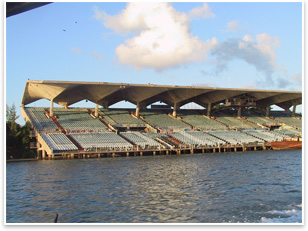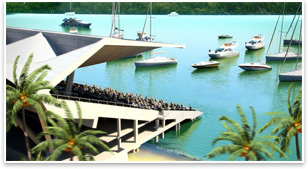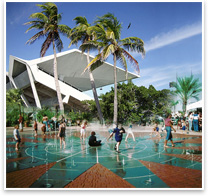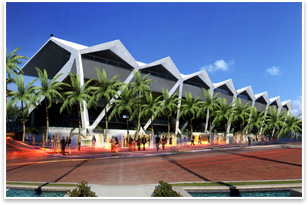
| Miami Marine Stadium Wins Historic Designation
Summary: The City of Miami’s Historic and Environmental Preservation Board has nominated the Miami Marine Stadium for historic landmark status from the National Trust for Historic Preservation. Miami-based Friends of Miami Marine Stadium, under the umbrella of Dade Heritage Trust, has been working with AIA Miami in seeking to restore the 1964 concrete Modern structure that sits on the Virginia Key barrier island facing Biscayne Bay and features a view of the downtown Miami skyline. In its heyday, Miami Marine Stadium hosted power boat racing, floating concerts by legendary performers, Easter services, and even a rally for then-President Nixon. The 6,500-seat cantilevered grandstand, one of the largest unsupported concrete spans in the world, was abandoned in 1992 when it was devastated by Hurricane Andrew. Declared unsafe by the City of Miami, it has not been used since.
“We will go back to Miami’s preservation board in several months to designate the structure,” says Don Worth, Friends of Miami Marine Stadium co-founder. “Beyond that, larger issues remain that include funding the rehabilitation costs and operating it. It won’t be an easy fight, but I think we have a great opportunity, because the structure is remarkable and loved by many people. It has played a large role in community memory. It’s an only-in-Miami experience.”
Worth’s adaptive reuse proposals include concerts; participatory athletic events, such as dragon boat racing, triathlons, wakeboarding, and long-distance swimming; powerboat racing; site location shoots for movies and television; and creative events. “I think there is an active portfolio of activity that spreads out and can hit a number of demographics,” he concludes. “The size of the stadium is actually a sweet spot in terms of events, and the visuals and setting are beyond spectacular.” |
||
Copyright 2008 The American Institute of Architects. All rights reserved. Home Page |
||
news headlines
practice
business
design
Visit the Friends of Miami Marine Stadium Web site for more information.
Did you know ...
Originally built for power boat racing, the stadium’s floating stage
hosted legendary performers including Jimmy Buffett, Bonnie Raitt, and
Mitch Miller; Easter services; flotillas; the Miami Pops and the Boston
Pops; and television shows. Clambake, an Elvis Presley movie,
was shot there, and Sammy Davis Jr. once hugged President Richard Nixon
at a rally there.
Do You Know SOLOSO?
The AIA’s resource knowledge base can connect you to the AIA Best Practices article “Integrating Sustainability and Historic Preservation.”
See what else SOLOSO has to offer for your practice.
From the AIA Bookstore: Structural Anaylsis of Historic Buildings: Restoration, Preservation, and Adaptive Reuse Applications, by J. Stanley Rabun, 2000.
Captions
1. Friends of Miami Marine Stadium envisions concerts and creative events at Miami Marine Stadium.
2. Miami Marine Stadium currently sits in neglect.
3. Adaptive reuse proposals by Friends of Miami Marine Stadium include various boating activities.
4. A public charrette in June 2007 showed support for its renovation and reuse.
5. The 6,500-seat, cantilevered grandstand is one of the largest unsupported concrete spans in the world.

 How do you . . .
How do you . . . Miami Marine Stadium sits on the northeastern edge of the Rickenbacker
Causeway in Miami, overlooking Biscayne Bay. The stadium, one of
the first major U.S. structures to be designed by a Cuban-born architect,
is the brainchild of Hilario Candela, FAIA, who worked in the early ‘60s with architect Albert Ferendino to design Miami Marine Stadium as a poured-in-place concrete grandstand structure for power boat races and other aquatic events. Candela is currently involved in the efforts to restore Miami Marine Stadium.
Miami Marine Stadium sits on the northeastern edge of the Rickenbacker
Causeway in Miami, overlooking Biscayne Bay. The stadium, one of
the first major U.S. structures to be designed by a Cuban-born architect,
is the brainchild of Hilario Candela, FAIA, who worked in the early ‘60s with architect Albert Ferendino to design Miami Marine Stadium as a poured-in-place concrete grandstand structure for power boat races and other aquatic events. Candela is currently involved in the efforts to restore Miami Marine Stadium. Concrete and grandstand as regional metaphor
Concrete and grandstand as regional metaphor “Only in Miami” redux
“Only in Miami” redux Worth says that the Miami Marine Stadium also serves as a unifying symbol for the city. “This is a structure that needs to be reinvented,” he says. “I have spent my time looking at programming issues for the stadium because that is the key. Yes, the building is great, but if you can’t use it for anything, then what are we doing?”
Worth says that the Miami Marine Stadium also serves as a unifying symbol for the city. “This is a structure that needs to be reinvented,” he says. “I have spent my time looking at programming issues for the stadium because that is the key. Yes, the building is great, but if you can’t use it for anything, then what are we doing?”